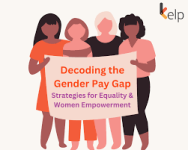The gender pay gap is still one of the most stubborn and hotly debated topics in Human Resource Management (HRM) today. Even after years of striving for gender equality, women around the globe are still earning less than men for doing the same work. Tackling this issue means not just pinpointing its root causes but also promoting transparency in salary structures. This approach challenges the traditional ways of compensating employees and ignites discussions among employers, employees, and policymakers.
Understanding the Gender Pay Gap
So, what exactly is the gender pay gap? It’s the difference in average earnings between men and women, usually shown as a percentage of what men make. On a global scale, women generally earn about 80-85% of men’s earnings. This gap is the result of a tangled web of factors, including occupational segregation, variations in work experience, educational differences, negotiation gaps, and—most importantly—discrimination.
Many women find themselves stuck in lower-paying jobs or industries, while men often hold the higher-paying leadership roles. Plus, societal expectations around caregiving tend to hit women harder, affecting their career paths and leading to breaks or part-time work that only serve to widen the pay gap.
The Role of Transparency
Salary transparency has become a vital weapon in the battle against gender pay inequality. When companies openly disclose pay ranges and the criteria behind compensation, they minimize the chances of hidden biases affecting salary decisions. This openness helps employees grasp how their pay is determined, making it easier to spot any gender-based discrepancies.
Countries like Iceland have taken the lead by enacting laws that require businesses to demonstrate pay equity and publish salary information. In the U.S., several states and cities have begun mandating salary range disclosures in job listings. These policies have ignited passionate discussions: supporters argue that transparency fosters fairness and accountability, while opponents contend it invades privacy and could stir up tensions in the workplace.
Benefits of Salary Transparency
1. Reduces Discrimination: Transparency shines a light on unfair pay practices, compelling organizations to tackle unjust disparities.
2. Enhances Trust: Open pay policies cultivate trust between employees and management by promoting a sense of fairness.
3. Empowers Employees: Understanding salary ranges gives employees the upper hand when it comes to negotiating their pay.
4. Improves Recruitment and Retention: Companies known for fair pay are more likely to attract and keep top talent.
Challenges and Criticisms
Despite its advantages, salary transparency does come with its own set of challenges. Some employers worry that sharing pay data might lead to dissatisfaction or jealousy among staff. Others are concerned about losing their competitive edge by revealing their compensation structures. Moreover, transparency by itself won't close the pay gap; it needs to be paired with fair hiring practices, unbiased performance evaluations, and strong diversity initiatives.
Moving Forward: Best Practices for HR
To tackle the gender pay gap effectively, HR professionals should take a well-rounded approach:
The gender pay gap isn’t just a statistic; it highlights deeper societal inequalities that impact the economic security and career opportunities of countless women. Embracing salary transparency could be a powerful way to foster fairness and help bridge this gap. Yet, it takes real courage and dedication from organizations to shake things up and challenge the norm. By adopting transparency along with fair HR practices, companies can create a more inclusive workplace—one where talent is recognized and valued equally, no matter the gender.
Image source :- Redirect Notice
Understanding the Gender Pay Gap
So, what exactly is the gender pay gap? It’s the difference in average earnings between men and women, usually shown as a percentage of what men make. On a global scale, women generally earn about 80-85% of men’s earnings. This gap is the result of a tangled web of factors, including occupational segregation, variations in work experience, educational differences, negotiation gaps, and—most importantly—discrimination.
Many women find themselves stuck in lower-paying jobs or industries, while men often hold the higher-paying leadership roles. Plus, societal expectations around caregiving tend to hit women harder, affecting their career paths and leading to breaks or part-time work that only serve to widen the pay gap.
The Role of Transparency
Salary transparency has become a vital weapon in the battle against gender pay inequality. When companies openly disclose pay ranges and the criteria behind compensation, they minimize the chances of hidden biases affecting salary decisions. This openness helps employees grasp how their pay is determined, making it easier to spot any gender-based discrepancies.
Countries like Iceland have taken the lead by enacting laws that require businesses to demonstrate pay equity and publish salary information. In the U.S., several states and cities have begun mandating salary range disclosures in job listings. These policies have ignited passionate discussions: supporters argue that transparency fosters fairness and accountability, while opponents contend it invades privacy and could stir up tensions in the workplace.
Benefits of Salary Transparency
1. Reduces Discrimination: Transparency shines a light on unfair pay practices, compelling organizations to tackle unjust disparities.
2. Enhances Trust: Open pay policies cultivate trust between employees and management by promoting a sense of fairness.
3. Empowers Employees: Understanding salary ranges gives employees the upper hand when it comes to negotiating their pay.
4. Improves Recruitment and Retention: Companies known for fair pay are more likely to attract and keep top talent.
Challenges and Criticisms
Despite its advantages, salary transparency does come with its own set of challenges. Some employers worry that sharing pay data might lead to dissatisfaction or jealousy among staff. Others are concerned about losing their competitive edge by revealing their compensation structures. Moreover, transparency by itself won't close the pay gap; it needs to be paired with fair hiring practices, unbiased performance evaluations, and strong diversity initiatives.
Moving Forward: Best Practices for HR
To tackle the gender pay gap effectively, HR professionals should take a well-rounded approach:
- Regularly conduct pay audits to spot and fix any disparities.
- Establish clear and objective criteria for making salary decisions.
- Create a culture where open conversations about pay are encouraged.
- Support career development initiatives for underrepresented groups.
- Advocate for flexible work policies that cater to diverse needs.
The gender pay gap isn’t just a statistic; it highlights deeper societal inequalities that impact the economic security and career opportunities of countless women. Embracing salary transparency could be a powerful way to foster fairness and help bridge this gap. Yet, it takes real courage and dedication from organizations to shake things up and challenge the norm. By adopting transparency along with fair HR practices, companies can create a more inclusive workplace—one where talent is recognized and valued equally, no matter the gender.
Image source :- Redirect Notice


